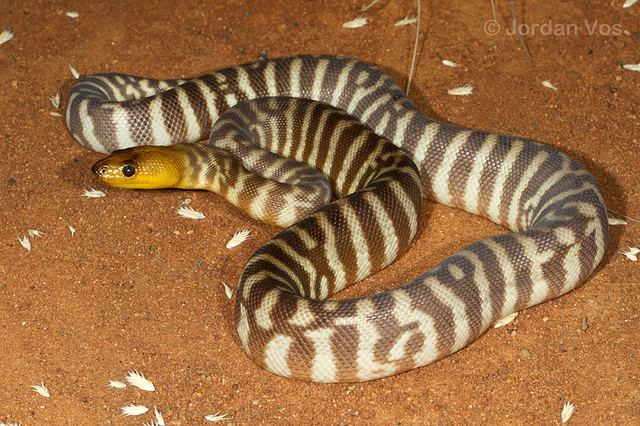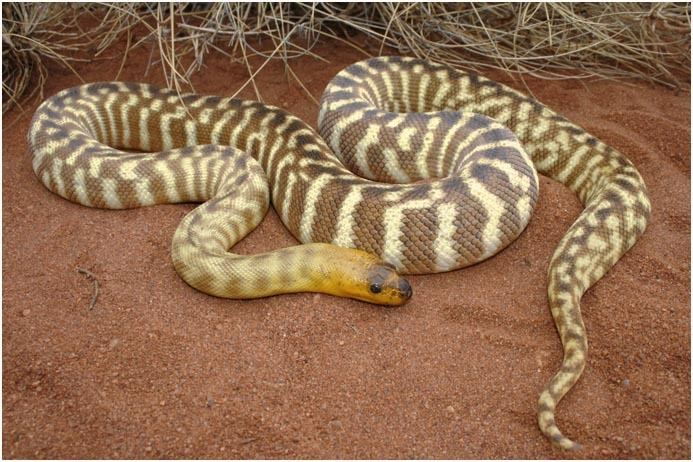Kingdom Animalia Subphylum Vertebrata Suborder Serpentes Scientific name Aspidites ramsayi Rank Species | Phylum Chordata Order Squamata Genus Aspidites Higher classification Aspidites | |
 | ||
Similar Snake, Python family, Reptile, Aspidites, Aspidites melanocephalus | ||
Woma aspidites ramsayi
Aspidites ramsayi, commonly known as Ramsay's python, woma python, and sand python, is a species of snake endemic to Australia. Once common throughout Western Australia, it has become critically endangered in some regions.
Contents
- Woma aspidites ramsayi
- Woma python aspidites ramsayi care video
- Etymology
- Taxonomy
- Description
- Geographic range
- Conservation status
- Behavior
- Feeding
- Reproduction
- Captivity
- References

Woma python aspidites ramsayi care video
Etymology
The generic name, Aspidites, translates to "shield bearer" in reference to the symmetrically shaped head scales.
The specific name, ramsayi, is in honor of Australian zoologist Edward Pierson Ramsay.
Taxonomy
This is one of two species of Aspidites, the pitless pythons, an Australian genus of the family Pythonidae.
Description

Adults average 1.5 m (4.5 feet) in total length. The head is narrow and the eyes small. The body is broad and flattish in profile while the tail tapers to a thin point.

The dorsal scales are small and smooth, with 50-65 rows at midbody. There are 280-315 ventral scales, an undivided anal plate, and 40-45 mostly single subcaudal scales. Some of the posterior subcaudals may be irregularly divided.

The color may be pale brown to nearly black. The pattern consists of a ground colour that varies from medium brown and olive to lighter shades of orange, pink, and red, overlaid with darker striped or brindled markings. The belly is cream or light yellow with brown and pink blotches. The scales around the eyes are usually a darker color than the rest of the head.
A. ramsayi may reach a total length of 2.3 m (7.5 ft), with a snout-vent length (SVL) of 2.0 m (6.6 ft).

Snakes of the genus Aspidites lack the heat sensing pits of all other pythons. Aspidites ramsayi is similar in appearance to Aspidites melanocephalus, but without an obvious neck. The colouration or desire to locate this species may lead to confusion with the venomous species Pseudonaja nuchalis, commonly known as the gwardar.
Geographic range
Found in Australia in the west and center of the country: from Western Australia through southern Northern Territory and northern South Australia to southern Queensland and northwestern New South Wales. Its range may be discontinuous. The type locality given is "near Forte Bourke" [New South Wales, Australia].
The range in Southwest Australia extends from Shark Bay, along the coast and inland regions, and was previously common on sandplains. The species was recorded in regions to the south and east, with once extensive wheatbelt and goldfield populations.
Conservation status
This species is classified as Endangered (EN) on the IUCN Red List of Threatened Species. A species is listed as such when the best available evidence indicates that a population reduction of at least 50% has occurred over the last 10 years or three generations, whichever is the longer, based on a decline in area of occupancy, extent of occurrence and/or quality of habitat. It is therefore considered to be facing a very high risk of extinction in the wild.
The Adelaide Zoo in South Australia is co-ordinating a captive breeding program for the species, and the offspring raised have been released into the Arid Recovery Reserve in the states north with no success due to mulga snake, Pseudechis australis, predation.
Many populations in the southwest of the country, since the 1960s, became critically endangered by altered land use. The sharp decline in numbers, without an authenticated record since 1989, was most notable in the Wheatbelt areas.
Behavior
This species is largely nocturnal. By day this snake may be found sheltering in hollow logs or under leaf debris. When travelling across hot sands or other surfaces it lifts its body off the ground and reaches far forward before pushing off the ground again, having only a few inches of its body touching the ground at a time.
Feeding
These snakes prey upon a variety of terrestrial vertebrates such as small mammals, ground birds, and lizards. They catch much of their prey in burrows where there is not enough room to maneuver coils around their prey; instead, the woma pushes a loop of its body against the animal to pin it against the side of the burrow. Many adult womas are covered in scars from retaliating rodents as this technique doesn't kill prey as quickly as normal constriction.
Although this species will take warm-blooded prey when offered, Aspidites ramsayi preys mainly on reptiles. Perhaps due to this, species within the Aspidites genus lack the characteristic heat sensing pits of pythons, although they possess an equivalent sensory structure in their rostral scales.
Reproduction
Oviparous with 5-20 eggs per clutch. Females remain coiled around their eggs until they hatch, with the incubation period lasting 2–3 months. An adult female that is about 4–5 years old and 5 feet (about 1.5 m) in total length will usually lay about 11 eggs.
Captivity
Considered to be more active than many pythons, as well as being a very docile and "easy to handle" snake, the woma is highly sought after in the reptile and exotic pet trade. They are one of the hardiest python species in captivity, often enthusiastically accepting prey and other items. One made headlines in May 2015 for requiring surgery to remove the feeding tongs it had swallowed as well as its meal. Although it is considered to be an endangered species, mainly due to the destruction of its natural habitat, this snake will breed in captivity.
